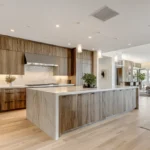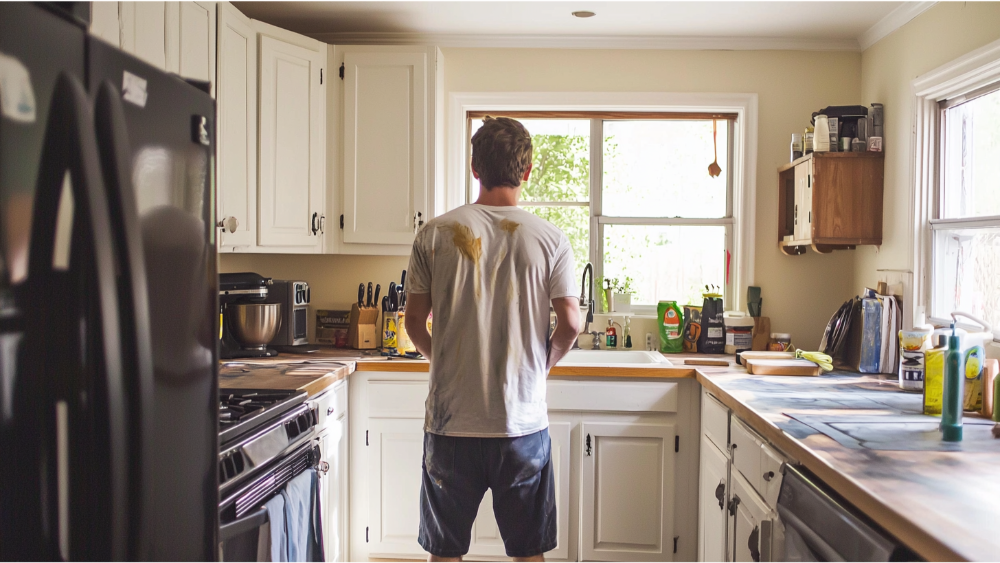
Revamping your kitchen countertops with a fresh coat of paint is an affordable and creative way to transform the heart of your home. This DIY project allows you to customize your countertops to match your style while avoiding the high cost of replacement. With the right tools and techniques, you can achieve a durable and professional-looking finish.
Reach out to America’s Advantage Remodeling for any help you might need!
Types of Countertops That Can Be Painted
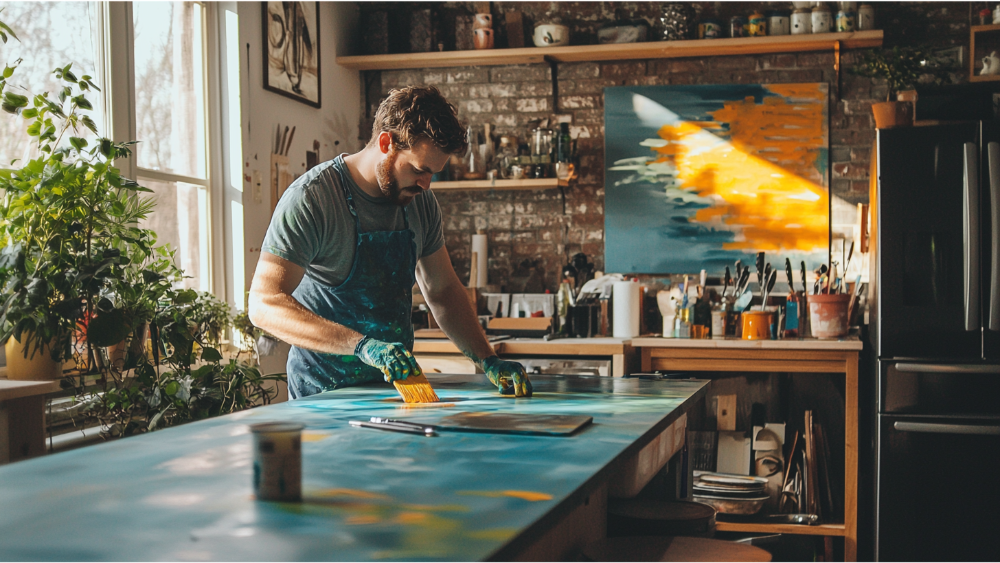
Laminate Countertops
Laminate countertops are among the easiest and most popular surfaces to revamp with countertop paint. Their smooth surface allows for excellent adhesion when paired with the right primer and paint. To paint laminate countertops, ensure the surface is thoroughly cleaned and lightly sanded to remove any glossy finish, which helps the paint stick better. With proper preparation and sealing, you can give laminate countertops a fresh, modern look that mimics more expensive materials, such as stone or wood. This is an affordable solution for homeowners seeking an updated style without the expense of replacing laminate entirely.
Wood Countertops
Painting wood countertops is another great way to refresh your kitchen design while preserving the warmth and character of the material. The natural grain of wood can shine through with the proper painting technique, providing a rustic or contemporary aesthetic, depending on your preference. Use a primer designed for wood surfaces before applying countertop paint to ensure durability and reduce the risk of peeling or chipping. Sanding is crucial for creating a smooth surface and enabling even coverage of the paint. A protective sealer, like polyurethane, will further fortify the surface against scratches and moisture.
Granite Countertops
While painting granite countertops may seem unconventional, it is possible to transform them with countertop paint designed specifically for tougher surfaces. Achieving a professional finish requires extra preparation, as granite is non-porous and very smooth. Start by thoroughly cleaning the surface and sanding it lightly to give the paint something to adhere to. Applying a high-adhesion primer is essential when working with granite countertops to ensure the painted finish lasts over time. Although granite is known for its natural beauty, painting it can be a cost-effective way to adapt your paint countertops to a new color scheme or design style.
Tile Countertops
Tile countertops can also be painted, allowing you to reinvent their look without the labor or expense of retiling. Use paint designed for both the tiles and grout to ensure a cohesive and long-lasting finish. Start by cleaning the tiles thoroughly, sanding them lightly, and applying a primer to create a suitable base for your countertop paint. You can opt for a sleek single-color finish or use stencils to create intricate designs and patterns on your tiles. A durable topcoat is necessary to protect the surface from wear and moisture, making it both functional and stylish.
Concrete Countertops
Concrete countertops provide a blank canvas for creativity, making them highly adaptable to paint transformations. Their porous nature ensures that countertop paint adheres well when paired with an appropriate primer. Before painting, ensure the surface is clean and free of debris, and consider filling any cracks for a seamless final look. You can achieve a variety of finishes, from a smooth matte surface to a high-gloss result, depending on the paint type and technique. By sealing the painted concrete countertops thoroughly, you’ll achieve lasting durability and resilience against daily kitchen use.
Solid Surface Countertops
Solid surface countertops, such as Corian, can be painted to give them a fresh new appearance without the need for replacement. These countertops are non-porous and require proper preparation to ensure the paint adheres effectively. Start by cleaning the surface thoroughly to remove grease or residue, then lightly sand it to create a texture for the primer to cling to. Use a high-quality primer and paint specifically designed for countertops to achieve a smooth and durable finish. A protective topcoat is essential to safeguard the painted surface against scratches, stains, and heat, extending the life of your newly revamped countertops.
Tools and Materials Needed
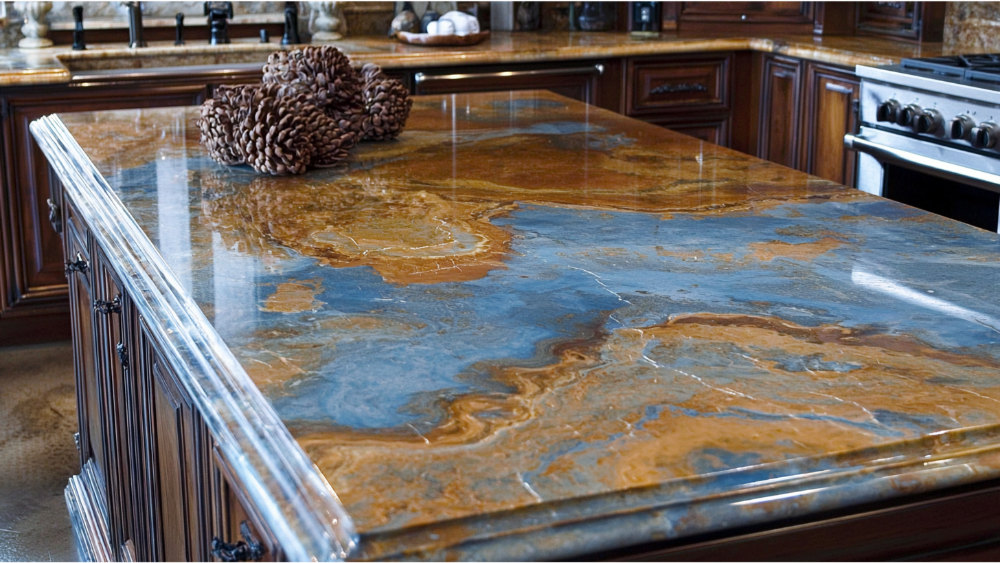
Countertop Paint Kits
Countertop paint kits are specifically designed to simplify the painting process and include all the essential products, such as primer, paint, and topcoat. These kits are tailored to different types of countertop materials, ensuring a durable and cohesive finish. Opt for a kit that matches your specific countertop surface, whether it’s laminate, wood, or tile.
Soap and Water
Before painting, thoroughly clean your countertops using a mix of soap and water to remove grease, dirt, and obstructions that could affect adhesion. A clean surface ensures that the primer and paint bond properly to the countertop materials, preventing peeling or bubbling over time. Use a microfiber cloth or sponge for gentle but effective cleaning.
Sandpaper or Sanding Blocks
Sanding is crucial for creating a slightly rough surface that allows paint and primer to adhere better. For smooth surfaces, such as ceramic tile or granite, use medium to fine-grit sandpaper to scuff the surface lightly. Always wipe away dust with a damp cloth after sanding to maintain a clean working area and prepare for a smooth finish.
Primer
A high-quality primer helps to ensure that the paint properly adheres to different countertop materials like laminate, granite, or concrete. Select a primer appropriate for non-porous surfaces, such as ceramic tile or solid surface countertops, to guarantee a long-lasting finish. Apply the first coat of primer evenly with a roller or bristle brush and allow it to dry completely before painting. If needed, apply a second coat for even coverage and better adhesion.
Epoxy Coating or Topcoat
Epoxy coating or a clear topcoat provides a protective finish that extends the lifespan of your painted countertops. It helps seal the paint, making the surface resistant to scratches, moisture, and heat. Apply multiple layers if recommended, starting with a thin coat and allowing each coat to cure fully for maximum durability. A final smooth finish can be achieved by following the manufacturer’s guidelines carefully.
Painter’s Tape
Use painter’s tape to protect adjacent areas, such as walls, sinks, and appliances, from accidental paint strokes or drips. This ensures clean edges and a professional-looking finish without the need for extensive touch-ups.
Brushes and Rollers
High-quality brushes and foam rollers are essential for even application of paint and topcoat. A foam roller works well for large, flat surfaces, while angled brushes or a bristle brush are useful for painting edges and detailed areas. For the best results, use a thin coat for the first coat, and follow up with a second coat to achieve a streak-free, smooth finish on your newly painted countertops.
Design Ideas for Painted Countertops
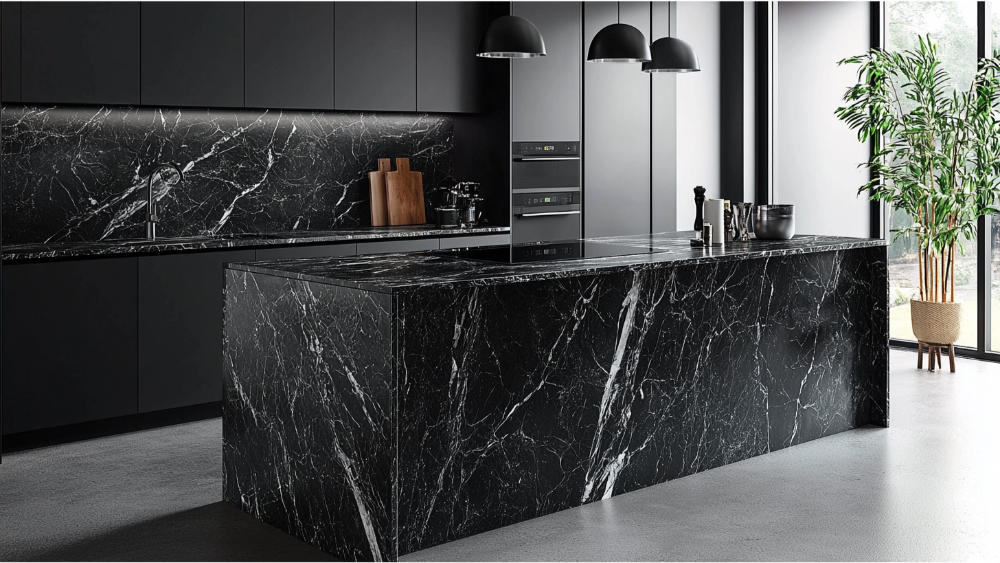
Faux Marble Finish
Transform your existing countertops into elegant marble countertops using specialized countertop paint techniques. This design works particularly well for bathroom countertops, where a luxurious aesthetic is often desired. Begin by applying a base color, such as white or light gray, and use a fine artist’s brush to mimic natural marble veins with darker shades. Seal the finished design with a heat-resistant topcoat to ensure longevity and protect it from daily wear.
Bold and Vibrant Color Theme
For a modern or eclectic look, consider bold hues like navy blue, emerald green, or deep burgundy for your countertops. This idea works great when coordinated with neutral-colored cabinetry, allowing the countertops to take center stage. Ensure the paint used is heat resistant if the design is intended for kitchen use to safeguard against hot pots and dishes. By updating your existing countertops with striking colors, you can create a fresh focal point in the space.
Two-Tone Countertops
Achieve a contemporary style by incorporating a two-tone design into your painted countertops. For example, create a light base on the outer sections of your kitchen island and a darker central area for a visually appealing contrast. This style can work beautifully in both kitchens and bathrooms and can be easily tailored to any color scheme. Don’t forget to apply a heat-resistant finish, especially for high-use areas, to ensure your countertops remain durable and functional.
Concrete Look
Add an industrial-inspired touch by painting your countertops to mimic the appearance of polished concrete. This works wonderfully for both bathroom and kitchen countertops, offering a sleek, minimalistic style. Use gray tones with subtle speckling effects created with a sponge technique to achieve a realistic concrete texture. A topcoat with heat-resistant properties is essential for kitchen applications to protect the look from heat and daily wear.
Custom Patterns and Stenciling
For a truly unique countertop design, consider using stencils to apply intricate patterns or geometric shapes. This idea is ideal for existing countertops that need an artistic refresh, particularly in bathrooms or modern kitchens. Choose a combination of complementary colors and take your time with each section to ensure crisp, clean lines. Protect the final design with a durable, heat-resistant topcoat to maintain both style and function.
Frequently Asked Paint Kitchen Countertops Questions
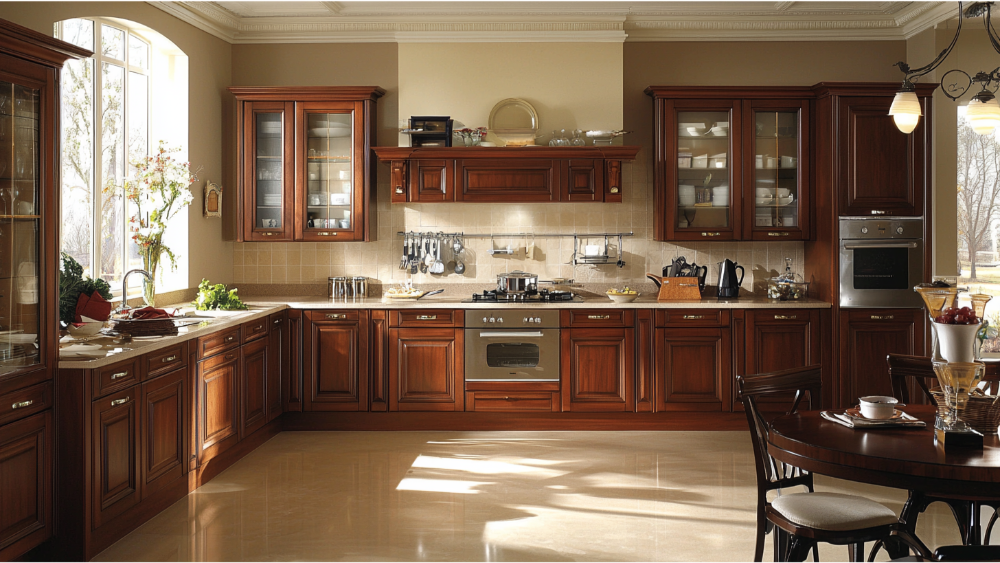
Is Painting Kitchen Countertops a Good Idea?
Painting kitchen countertops can be a cost-effective and versatile way to refresh the look of your kitchen without the expense of a full renovation. It allows homeowners to customize the design of their countertops with a wide range of colors, patterns, and finishes, from classic faux marble to bold contemporary hues.
It’s important to consider a few factors before deciding. Painted countertops require proper preparation and high-quality materials, including primers and topcoats, to ensure durability and protect against scratches, heat, and moisture. While painting countertops is a relatively simple DIY project, it may not be as long-lasting as replacing them with new materials. For those seeking a budget-friendly and creative solution, painting is a great option, providing you’re committed to regular maintenance and care to preserve the finish.
Does Painting a Countertop Last?
The longevity of a painted countertop depends largely on the preparation, materials used, and the level of care it receives. When high-quality primer, paint, and a durable topcoat are applied correctly, painted countertops can last several years with minimal wear and tear. Proper prep work, such as sanding and cleaning the surface thoroughly, helps create a strong base for the paint to adhere to, reducing the risk of peeling or chipping.
It’s essential to note that painted countertops are not as hardwearing as traditional materials like quartz or granite. Heavy use, exposure to sharp objects, and consistent heat can eventually cause damage. To prolong the life of a painted countertop, it’s recommended to use cutting boards, trivets, and placemats regularly. Periodic reapplication of the protective topcoat can help extend its lifespan and maintain its appearance. While not permanent, painted countertops are a budget-friendly and customizable option for refreshing a space when cared for properly.
What Kind of Paint Do You Use on Kitchen Countertops?
For painting kitchen countertops, it’s crucial to use a durable, heat-resistant, and moisture-resistant paint. Acrylic enamel paint is often recommended, as it provides a hard, glossy finish suitable for high-traffic surfaces. Epoxy paints are another excellent choice due to their exceptional durability and resistance to chipping and stains. Always pair the paint with a quality primer to ensure proper adhesion and a smooth finish. Lastly, seal the painted countertops with a clear, heat-resistant topcoat to protect against daily wear and maintain their appearance over time.
Conclusion
Painting kitchen countertops is an affordable and creative way to breathe new life into your space without undergoing a full renovation. With an array of techniques, colors, and finishes to choose from, this DIY project offers endless opportunities for customization to suit your personal style and home decor. While painted countertops may require more care and maintenance compared to traditional materials, the proper preparation and use of high-quality paints and finishes can ensure a durable and beautiful result. Whether you’re aiming for the elegance of faux marble, the vibrancy of bold colors, or the sleek modernity of a concrete look, a little effort and attention to detail can transform your countertops into stunning focal points.
CONTACT US
Our Services
Areas We Serve
Certificate






